Growing chili peppers at home on a windowsill or balcony
Hot chili pepper is not just a spice that is often used in cooking meat dishes, but also a pretty beautiful plant. Many vegetable growers are engaged in planting it. Most often they try to grow hot peppers on a windowsill. Some people grow pepper on the balcony. Growing bell peppers on your own at home is not so easy. Therefore, it is recommended that you familiarize yourself in advance with how to grow hot peppers on the windowsill and how to care for chili peppers.
The best varieties for home
Before growing hot peppers from seeds at home, you need to decide on the best peppers for this. There are several undersized species that are ideal for growing chili at home in a pot.
Treasure Island
Most often it is bought for growing a house on a window. He has an average time of fruit ripening. The first harvest of the variety can be harvested 110 days after planting the seeds in pots. The grown fruits are heart-shaped and red in color with an orange tint. They are not very big, as their average weight is 60-80 grams.
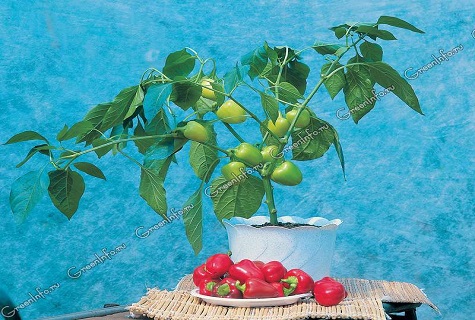
Gift from Moldova
Many growers grow these chili peppers at home. It will not be suitable for lovers of an early harvest, since the first peppers will begin to sing only 140 days after planting. During the cultivation of the variety, rather large dark red fruits are formed on the bushes. Each of them weighs approximately 80-100 grams. Their distinctive feature is the taste, which contains bitterness, mixed with a slight sweetness.

Watercolor
Such sweet peppers grow well on the windowsill or on the balcony. The fruits of the variety fully ripen 110 days after sowing the seeds. They are distinguished by a conical shape and a scarlet color of the skin. The size of the Aquarelle fruits is very small, since the weight of each of them rarely exceeds 30 grams.
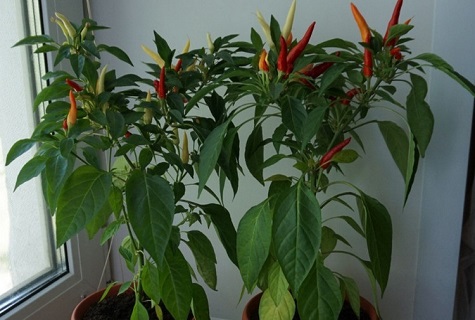
Dwarf
Quite often, the variety is purchased to carry out the cultivation of chili peppers on the windowsill. A distinctive feature of the variety can be considered its fruits. They are tapered and very fleshy. The dwarf is a mid-season pepper variety and ripens 100 days after the first shoots appear.
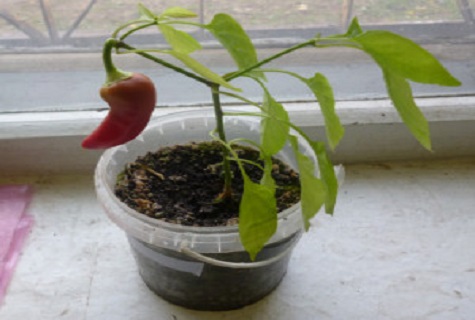
Siberian firstborn
This red pepper grows well not only on the balcony, but also outside. The fruits of the variety differ in their size and weight. Each pepper weighs at least 100 grams. All ripe fruits are colored bright red.
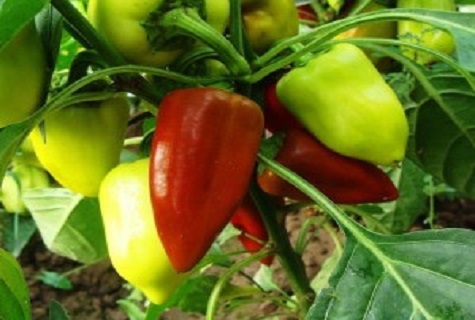
Seed preparation
Growing bell pepper at home begins with the preliminary preparation of the planting material. Only pre-prepared seeds can give a good harvest.

Calibration
To correctly select the highest quality seeds, you should start calibrating them. First, all seeds must be spread out on a flat surface and small seeds must be discarded. It is recommended to grow medium-sized seed.
You will need to use saline solution during calibration. Chili seeds should not be empty and therefore they need to be dipped in a solution made of 40 grams of salt and a liter of heated water for 5-10 minutes. Well-growing seeds will remain at the bottom of the container, and rejected seeds will immediately rise to the surface.

Disinfection
Before growing chili peppers in an apartment, it is recommended to disinfect all the seeds. If this is not done, then the likelihood of infection of the plant with one or another disease increases several times. For processing seeds, a solution made from manganese is very often used.
The seeds are placed in a container with a solution for 20-40 minutes, after which they will need to be rinsed with warm water and dried thoroughly.
Also, hot peppers can be treated with phytosporin. To prepare the solution, no more than four drops of the drug are added to a glass of water. In such a liquid, the seeds should be soaked for no more than 20 minutes.
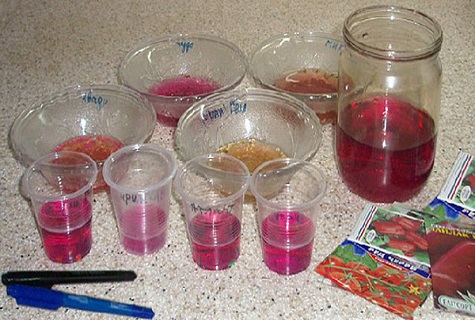
Soil preparation
Growing hot peppers at home should be carried out in pre-prepared soil. Therefore, before planting a plant, you should familiarize yourself with the basic recommendations for preparing the planting soil. It is recommended to plant the peppers in a specially purchased soil, which is best suited for growing sweet peppers on a windowsill. Such soil contains the necessary amount of trace elements that pepper bushes need.

Many inexperienced vegetable growers are wondering whether it is possible to prepare the soil for growing on their own. Definitely possible, and some gardeners prefer to prepare it on their own. For this, you can use regular garden soil. However, it will have to be impregnated with a manganese solution in advance and poured over with heated water. After that, you can start preparing the planting soil mixture. For this you will need:
- two parts of sod land;
- part of carefully sifted sand;
- part of the humus.
It is better to cultivate hot peppers in sod soil, which is taken from the place where meadow clover was grown. Also, during the preparation of the soil mixture, you can add a few tablespoons of ash to it. It is often used to lower the acidity of the earth. Sometimes special hydrogels are added to the soil. They are used to make the soil more airy and loose.
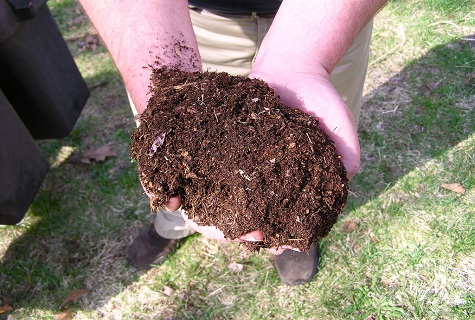
Planting
To figure out how to grow pepper on the balcony, you definitely need to familiarize yourself with the features of its planting. At home on a windowsill, cultivation should be done in small peat pots. Prepared planting soil is added to the containers in advance. Then small holes are made in it for planting seeds.
At the same time, the distance between landings should be at least 5 cm.
No more than two seeds sit in each pot. To make the seeds grow better, the grown pepper is covered with a polyethylene film and transferred to a warm room. Growing from seeds is a rather lengthy process, as seedlings only begin to emerge after a few weeks. When the bell peppers begin to sprout on the balcony, you will have to make several holes in the film. Over time, you can get rid of it.
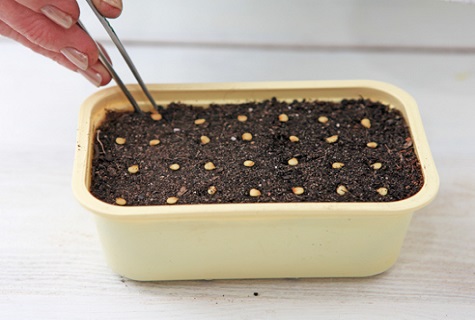
Picking
Before growing bell peppers, you will have to do a pick.This procedure is carried out when young seedlings become cramped in small peat pots. Indeed, over time, the root system begins to actively develop and for this it will need more free space. After a pick, the roots hold the soil ball better and become several times stronger. Also, this process has a positive effect on productivity.
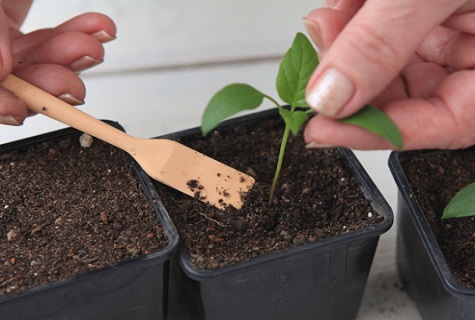
Step-by-step picking is performed as follows:
- a day before performing the procedure, the earth in containers will need to be filled with warm water;
- in the transplant container, you need to make a small depression in the very center in advance;
- a few hours before the pick, the soil near the sprouts is wetted with water;
- pull out young seedlings from peat pots very carefully so as not to damage the root system;
- when the plant is removed from the pot, the root will have to be shortened by a third;
- the seedlings are carefully placed in a new pot so that their leaves are above the ground and the roots are not bent;
- after transplanting, the soil should be compacted around the seedlings;
- the transplanted bushes should be watered with heated water.
Care features
Growing sweet peppers at home should be accompanied by proper care.
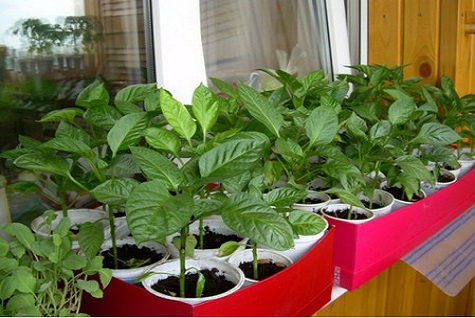
Pollination
To get a good harvest, you need to know how to pollinate peppers at home. Pollination is recommended when the petals of the plant are lowered down. If they are not bent, then pollination is not worth it.
Peppers are pollinated in a variety of ways. Quite often, this is done with a regular toothbrush. It must be very close to the inflorescence and touch it a little. This will be enough for pollination to occur.
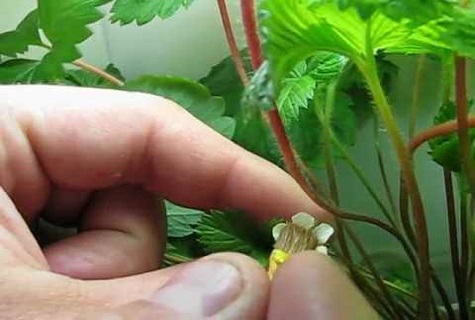
Watering
Young bushes need regular moistening of the earth and therefore worth it periodically water them to pepper was not very bitter. It is worth seriously doing watering a week after transplanting the grown seedlings. If the bushes are grown in a loggia, then they will have to be watered at least once a week. In the summer, you will have to do this more often, as the air temperature will rise and the soil will dry out faster. In this case, you will have to do this 2-3 times a week.
When watering, do not use too cold water, as it can damage the bushes. Therefore, it is recommended to preheat it on a gas stove or in the sun.
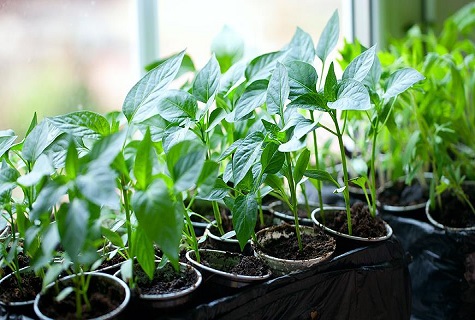
Top dressing
During cultivation, the bushes can pick up certain mineral elements. Therefore, you need to periodically feed the soil. To understand what exactly the seedlings are missing, it is recommended to carefully monitor the condition of their leaves:
- a dry crust appears at the edges of the leaves, and they begin to curl - not enough potassium (a little potassium nitrate or potassium sulfate should be added to the soil);
- the color of the leaves becomes dull - this indicates an insufficient amount of nitrogen (ammonium nitrate is added to the ground, which is one third of nitrogen);
- the leaves begin to stretch upward, and their color becomes purple - lack of phosphorus (phosphoric acid will have to be added to the soil);
- the crown of the leaves becomes marbled - an insufficient amount of magnesium (to solve the problem, the soil is fed with magnesium sulfate).
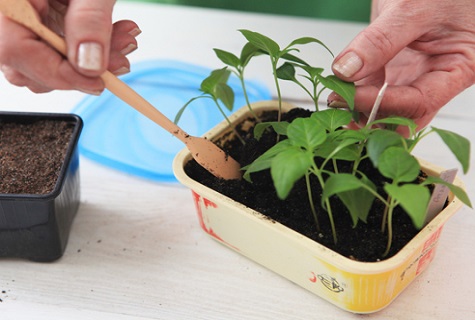
During dressing, it is not recommended to add chloride to the ground potassium or potassium salt... Their use can negatively affect the health of the root system.
Conclusion
Everyone can grow chili peppers at home. To do this, you will have to familiarize yourself with some of the recommendations for planting this plant in advance. You can also search for a video that will detail the cultivation and care of bell peppers at home.

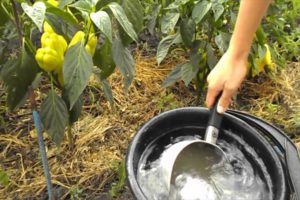
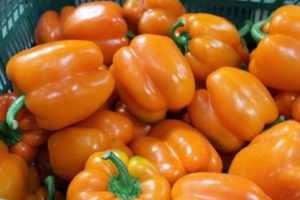


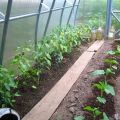

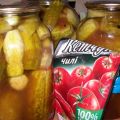

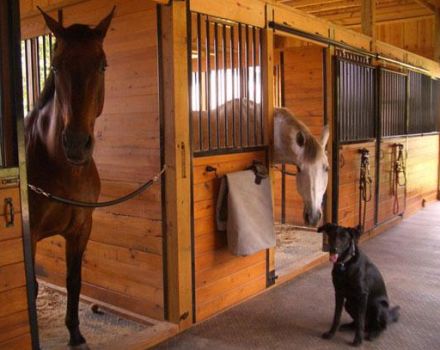
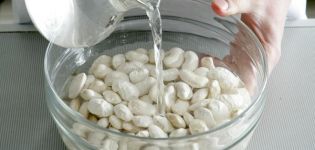
I have been growing chili peppers at home for many years now, in the summer I take the pots to the balcony, and in the winter I put them on the windowsill. I add a little BioGrow to the soil, it stimulates growth well. I bought it in this store.